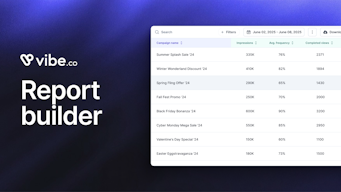Bring your "Live, Work, Play" campaigns to life with CTV
Beyond the Great Covid Reckoning of 2020, the retail and restaurant sectors had already been contending with rapid consumer behavior changes due to rapid digitization, urbanization, demand for more engaging, walkable environments, sustainability concerns, and more.
Today, one of the most compelling answers to these challenges is the rise of mixed-use, hybrid spaces centered around customer experience, community, and diverse commercial offerings. As evidenced by the unmitigated success of developments like Ponce City Market in Atlanta or the Historic Pearl in San Antonio, shoppers are hungry for new, diverse, walkable environments, and developers are happy to oblige.
Of course every rose has its thorn, so while retailers, restaurateurs, and developers are rising to the challenge and offering an increasing amount of experiential shopping environments to customers, marketers are faced with a new, complicated product to market - as both a B2B and a B2B offering.
That’s right, while developers hope for brand-level marketing campaigns that will attract new, long-term commercial tenants, individual tenants are focused on month to month bottom lines and working to attract a wide variety of shoppers. So how can marketers work to satisfy both needs in a coherent, cost-effective campaign? With a digital channel that boasts unparalleled brand building capabilities undergirded by a robust performance-focused engine: Connected Television!
How does CTV work?
In 2019, only 22% of US households owned a connected device; today, a whopping 94% of households have “cut the cord” to stream their favorite programs on Connected TVs, phones, or tablets. While this shift might seem minor from a consumer perspective (after all, watching TV is still just watching TV), the effect on advertisers is profound.
Because CTV advertising is a digital channel, operating with CPMs, pixels, Google Analytics, and other typically digital accouterments, it has managed to crack the TV advertising market wide open and radically democratize access to a notoriously expensive medium.
Today, advertisers of all sizes can upload simple 15 or 30 second long videos, set their budget, maximum CPM (Cost Per Thousand Impressions), target audiences, and deliver campaigns programmatically across hundreds of channels.
How to target campaigns with CTV
While brand building as a whole will benefit from CTV ads’ 97% VTR (View Through Rate) and audio-rich, un-skippable environment, more targeted retail and F&B focused campaigns will need to leverage more targeted campaign strategies. Some of the most interesting targeting dimensions, in this case, might be: location, household income, and channel inventory, among many others.
Let’s take a closer look.
Geo location targeting
Marketers can easily target campaigns by state, city, and/or zip code on the Vibe.co platform.
Household income targeting
Marketers can target customers within specific income brackets (among other demographic and interest targeting options) by campaign or by ad set within the campaign.
Contextual targeting by channel
Marketers can deliver their campaigns on over 600 premium apps and channels.


